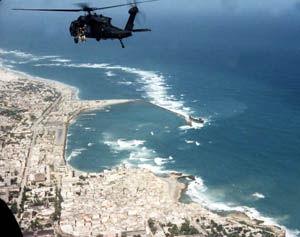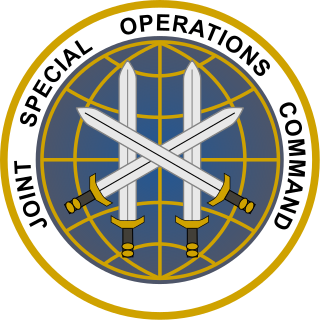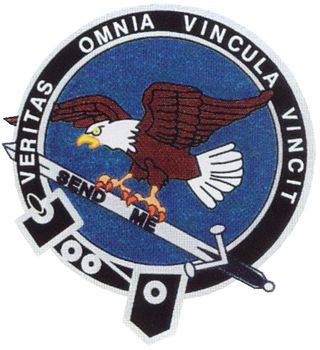Related Research Articles

Operation Anaconda or the Battle of Shah-i-Kot was a military operation that took place in early March 2002 as part of the War in Afghanistan. CIA paramilitary officers, working with their allies, attempted to destroy al-Qaeda and Taliban forces. The operation took place in the Shah-i-Kot Valley and Arma Mountains southeast of Zormat. This operation was the first large-scale battle in the post-2001 War in Afghanistan since the Battle of Tora Bora in December 2001. This was the first operation in the Afghanistan theater to involve a large number of U.S. forces participating in direct combat activities.

Gary Ivan Gordon was a master sergeant in the United States Army and a recipient of the Medal of Honor. At the time of his death, he was a non-commissioned officer in the United States Army's premier special operations unit, the 1st Special Forces Operational Detachment-Delta (1SFOD-D), or "Delta Force". Together with his comrade, Sergeant First Class Randy Shughart, Gordon was posthumously awarded the Medal of Honor for his actions during the Battle of Mogadishu in October 1993.

The Battle of Mogadishu, also known as the Black Hawk Down Incident, was part of Operation Gothic Serpent. It was fought on 3–4 October 1993, in Mogadishu, Somalia, between forces of the United States—supported by UNOSOM II—against the forces of the Somali National Alliance (SNA) and armed irregular citizens of south Mogadishu.

The 1st Special Forces Operational Detachment–Delta, referred to variously as Delta Force, Combat Applications Group (CAG), or within Joint Special Operations Command (JSOC), Task Force Green, is a special operations force of the United States Army, under operational control of JSOC. The unit's missions primarily involve counterterrorism, hostage rescue, direct action, and special reconnaissance, often against high-value targets.

The 160th Special Operations Aviation Regiment (Airborne), abbreviated as 160th SOAR (A), is a special operations force of the United States Army that provides helicopter aviation support for special operations forces. Its missions have included attack, assault, and reconnaissance, and these missions are usually conducted at night, at high speeds, low altitudes, and on short notice.

The Special Activities Center (SAC) is a division of the United States Central Intelligence Agency responsible for covert and paramilitary operations. The unit was named Special Activities Division (SAD) prior to 2015. Within SAC there are two separate groups: SAC/SOG for tactical paramilitary operations and SAC/PAG for covert political action.

The Joint Special Operations Command (JSOC) is a joint component command of the United States Special Operations Command (USSOCOM) and is charged with studying special operations requirements and techniques to ensure interoperability and equipment standardization, to plan and conduct special operations exercises and training, to develop joint special operations tactics, and to execute special operations missions worldwide. It was established in 1980 on recommendation of Colonel Charlie Beckwith, in the aftermath of the failure of Operation Eagle Claw. It is headquartered at Pope Field.

The 24th Special Tactics Squadron is one of the Special Tactics units of the United States Air Force Special Operations Command (AFSOC). Garrisoned at Pope Field, North Carolina, it is the U.S. Air Force component of Joint Special Operations Command (JSOC). The unit's webpage describes it as "the Air Force's special operations ground force".

The United States Army Intelligence Support Activity (USAISA), frequently shortened to Intelligence Support Activity (ISA), also known at various times as Mission Support Activity (MSA), Office of Military Support (OMS), Field Operations Group (FOG), Studies and Analysis Activity (SAA), Tactical Concept Activity, Tactical Support Team, and Tactical Coordination Detachment, and also nicknamed "The Activity" and the Army of Northern Virginia, is a United States Army Special Operations unit which serves as the intelligence gathering component of Joint Special Operations Command (JSOC). Within JSOC, the unit is often referred to as Task Force Orange. Originally subordinated to the US Army Intelligence and Security Command (INSCOM), it is one of the least known intelligence components of the United States military, tasked with clandestine HUMINT operations and collecting actionable intelligence during or prior to JSOC missions.

George Washington Crile III was an American journalist most closely associated with his three decades of work at CBS News. He specialized in dangerous and controversial subjects, resulting in both praise and controversy. He received an Emmy Award, Peabody Award, and Edward R. Murrow Award.
Takur Ghar is a high mountain located in the Arma Mountains of southeastern Afghanistan. The peak is on the eastern border of the Shah-i-Kot Valley.

The Battle of Tora Bora was a military engagement that took place in the cave complex of Tora Bora, eastern Afghanistan, from November 30 – December 17, 2001, during the final stages of the United States invasion of Afghanistan. It was launched by the United States and its allies with the objective to capture or kill Osama bin Laden, the founder and leader of the militant organization al-Qaeda. Al-Qaeda and bin Laden were suspected of being responsible for the September 11 attacks three months prior. Tora Bora is located in the Spīn Ghar mountain range near the Khyber Pass. The U.S. stated that al-Qaeda had its headquarters there and that it was bin Laden's location at the time.

The Battle of Takur Ghar was a short but intense military engagement between United States special operations forces and al-Qaeda insurgents fought in March 2002, atop Takur Ghar mountain in Afghanistan. For the U.S. side, the battle proved the deadliest entanglement of Operation Anaconda, an effort early in the War in Afghanistan to rout al-Qaeda forces from the Shahi-Kot Valley and Arma Mountains. The battle saw three helicopter landings by the U.S. on the mountain top, each met with direct assault from al-Qaeda forces. Although Takur Ghar was eventually taken, seven U.S. service members were killed and 12 others were wounded. The battle is also known as the Battle of Roberts Ridge, after the first casualty of the battle, Navy SEAL Neil C. Roberts.
The Safari Club was a covert alliance of intelligence services formed in 1976 that ran clandestine operations around Africa at a time when the United States Congress had limited the power of the CIA after years of abuses and when Portugal was dismantling its colonial empire in Africa. Its formal members were the pre-revolution (Pahlavi) Iran, Egypt, Saudi Arabia, Morocco and France. The group maintained informal connections with the United States, South Africa, Rhodesia and Israel. The group executed a successful military intervention in Zaire in response to an invasion from Angola. It also provided arms to Somalia in its 1977–1978 conflict with Ethiopia. It organized secret diplomacy relating to anti-Communism in Africa, and has been credited with initiating the process resulting in the 1979 Egypt–Israel peace treaty.
Graham Ragsdale is a former soldier of the Canadian Forces. He commanded the sniper team from the 3rd Battalion Princess Patricia's Canadian Light Infantry attached to the United States Army 187th Infantry Regiment, 101st Airborne Division during Operation Anaconda in the Shah-i-kot Valley, Paktia Province, Afghanistan in March 2002. The sniper team recorded more than 20 kills, including the long distance record combat kill of 2,430 metres (7,970 ft) set by Corporal Rob Furlong. Master Corporal Ragsdale, with selfless disregard for his own personal safety, operated his sniper team through extreme weather conditions at high altitude while under direct and indirect enemy fire aiding the success of the mission by identifying and neutralizing enemy targets and saving allied lives. He was awarded the United States Bronze Star Medal with "V" device for his actions in combat and was Mentioned in Despatches by the Canadian Forces for valiant conduct and meritorious service.

Brandon Friedman is an American writer, entrepreneur and former Obama administration official. He was CEO of the McPherson Square Group before co-founding Rakkasan Tea Company in 2017. Previously, he served as the deputy assistant secretary for public affairs at the United States Department of Housing and Urban Development.
Nathan E. Self is an American author and former United States Army officer.

Operation Rhino was a raid led by the United States Army's 75th Ranger Regiment and, who were led by Colonel Joseph Votel, and other SOCOM units on several Taliban targets in and around Kandahar, Afghanistan during the invasion of Afghanistan at the start of the War in Afghanistan. The operation was motivated by a desire for the White House and Tommy Franks to capture video footage of special forces parachuting deep into enemy territory. Intelligence reports at the time indicated that the targeted airfield was empty, leading them to believe that the Rangers would face no resistance from the Taliban. The operation has faced subsequent criticism for its focus on media portrayal rather than solely military objectives.

The 1st Brigade Combat Team, 10th Mountain Division is an active Infantry Brigade Combat Team of the United States Army based at Fort Drum in New York. The brigade headquarters carries the lineage of the 10th Mountain Division's original headquarters company, and served as such in World War II, and in peacetime at Fort Riley, Fort Benning, and West Germany in the 1940s and 1950s.
The Baraawe raid, code named Operation Celestial Balance, was a helicopter assault by United States Special Operations Forces against the al-Qaeda-linked terrorist Saleh Ali Saleh Nabhan and associated al-Shabaab militants near the town of Baraawe in southern Somalia.
References
- ↑ "Team House Podcast with Sean Naylor". 13 November 2021.